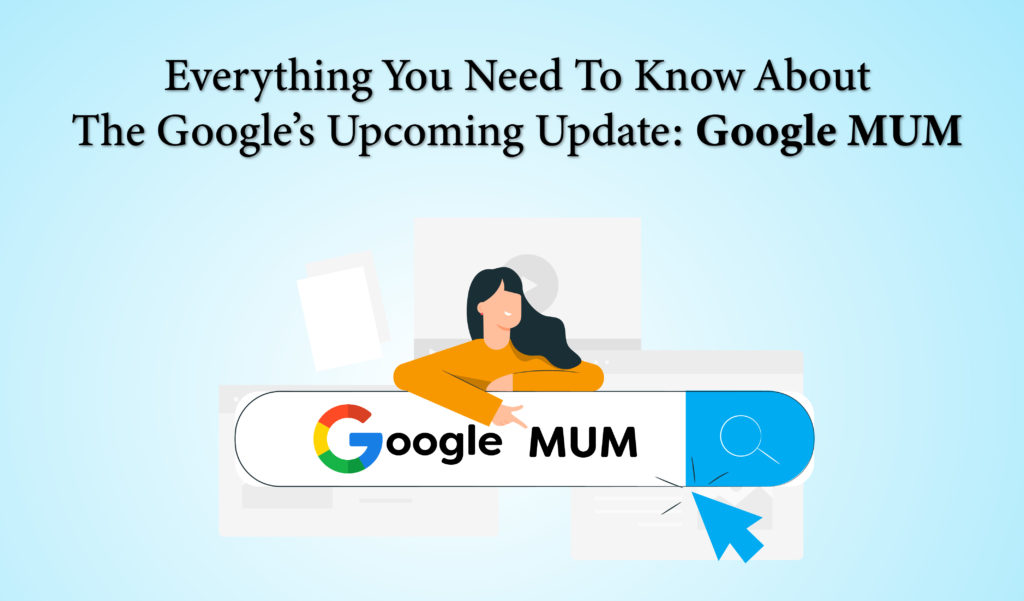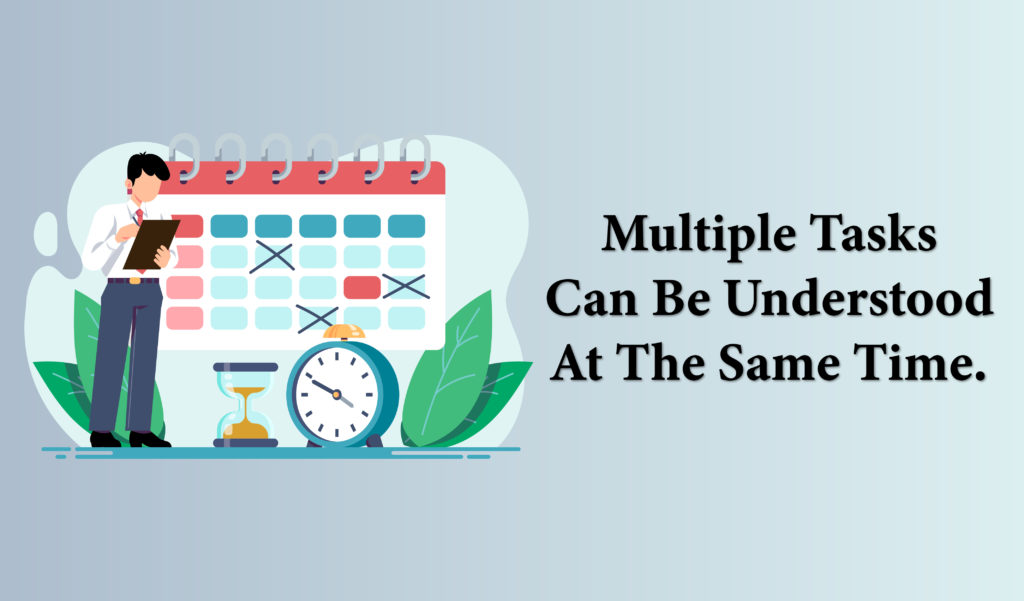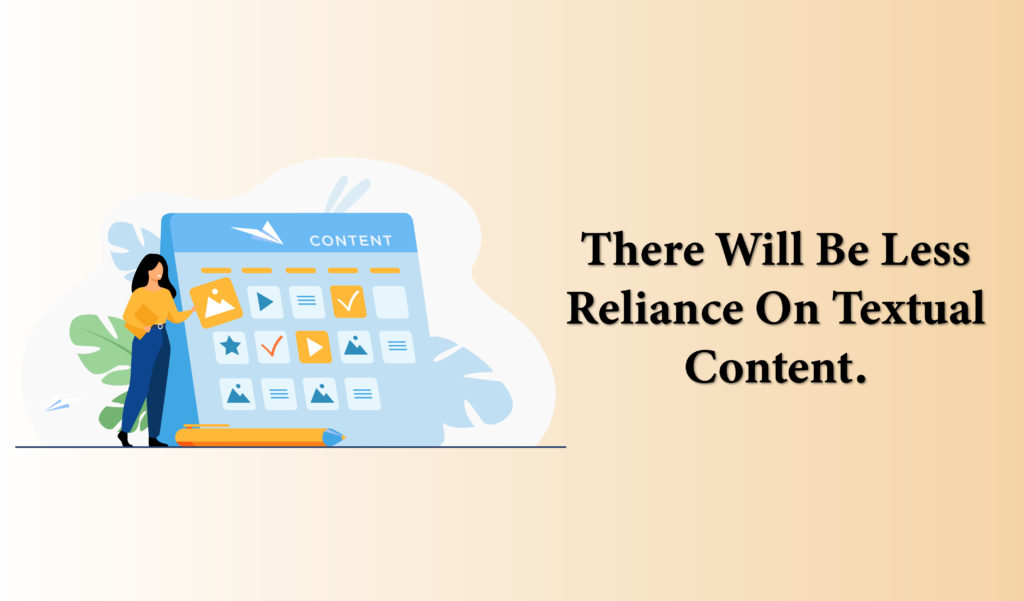Everything you need to know about Google’s upcoming update: Google MUM
Table of contents

After Core Web Vitals Google is now coming up with a new update- Google MUM. It’s said that the rollout for Google MUM is marked for early 2022. The Google SEO updates emphasis in these revisions is on search intent, focusing on reader demands, content quality, and formats. Many industry analysts believe it represents a significant advancement in Google’s AI capabilities. According to them, this upgrade may be more critical than the Penguin and Panda releases. This improvement has the potential to revolutionize the SEO game shortly.
MUM technology is created to assist with complications and cut down on queries. Google MUM (Multitask Unified Model) is a unique technology that uses machine learning to answer complex questions with no apparent answers. It was just radiated a few weeks ago, but it has already caused a stir in the SEO community.
The thoughts on this new AI technology will leverage what it knows about you and your interests to produce search results that are specifically suited to you. The blog will look at how this change might affect SEO and what marketers can do to get ready.
What is Google’s MUM?
Google revealed MUM, a new AI-based technology, during the 2019 Google I/O developer conference. MUM is an abbreviation for ‘Multitask Unified Model’, which appears to be rather powerful due to its capacity to comprehend any text. Google’s MUM Update is a machine learning algorithm that will aid Google’s SEO updates by providing better search results to consumers who are more inclined to click on them. It is a machine-learning-based system that will make web searches more efficient. It can better interpret any material and integrate disparate pieces of data to provide exact responses to complex search queries. It is a complicated query-solving system that can understand and produce 75 different languages. Unlike BERT, it manages to do multiple tasks simultaneously while developing a comprehensive comprehension of data. MUM is also multimodal, meaning it reads data from both text and visuals. In the future, video and audio files are expected to be added to the list of modalities.
This means that, to rank web pages in search engine results pages, Google’s algorithm will now rely less on term density. This artificial intelligence system is so sophisticated that it can answer your hard inquiries swiftly and accurately. By being taught 75 different languages, Google built this AI to understand the language and generate a detailed comprehension of the world’s knowledge.
MUM is a cutting-edge neural network that can extract data from web pages, documents (HTML, PDF), photos, and videos. It does more than just read the text to give users context about what they’re looking for by learning the connections between words. Because MUM can read things from all aspects, the more difficult questions will be handled seamlessly when you hire them.
For decades, Google has worked to make the world’s knowledge broadly available and valuable. Thanks to their new MUM AI technology, they’re one step closer now. The machine learning algorithm will be rolled out in Google SEO updates over the next few months in an iterative process. Google will monitor how users react before releasing it more widely or making changes based on feedback.
How does it work?
Every current search engine relies on the Information Retrieval process, yet indexing and ranking websites are insufficient for such duties. All search engines use keyword phrase recognition, conjunction, and semantics to generate a preliminary list of candidates for search results. Then it passes through one or more re-ranking patterns, most likely learning-to-rank patterns based on neural networks.
This technique eliminates the algorithm component responsible for obtaining the index: it is intended to merge and replace indexing, retrieval, and ranking elements into a Unified Model. It protects the data in a corpus by encrypting it. Consider the following screenshot from the article to better understand what’s going on: It demonstrates the difference between the traditional retrieve-then-rank method and the Single Model. There are evident parallels between the publication of this paper, which discusses the necessity of a single expression in the modern world, and the debut of a ground-breaking Google algorithm called MUM.
Interestingly, another study about Multitask Mixture of Sequential Experts for User Activity Streams, or MoSE, was released in December 2020. Although the names MoSE and MUM are different, there are some similarities with the MUM breakthrough. An essay explores neural multitask learning, which builds robust multistage scanning patterns using scanning and browsing history.
The system simulates finding relevant answers to specific questions by studying sequential mouse clicks and information scanning. It’s worth noting that MoSe uses Long Short-Term Memory (LSTM) to represent the researcher’s behavior rather than a request and context – the network’s chain of activities makes it evident which response will be satisfying. Also included in this article is a type of algorithm designed for video search based on three predictions:
- what people want to see;
- what would satisfy a request;
- which materials will generate greater engagement?
MoSE is most interested in a wide range of data kinds. When we look at this feature in the context of MUM, we can see what steps the crawler takes to find appropriate options. Client activity flows from several sites are modeled in this scenario, and their interaction is identified. Furthermore, MoSE can predict serial client searches and behavior as prominent representations, lowering the number of search queries and improving response to complex situations.
The more computational resources required for the algorithmic program’s functioning, the more powerful it can be, allowing it to scale—the verdict on the claim that MUM is 1000 times more powerful than BERT. The MoSE algorithm strikes a balance between minimum resource value and scanning quality. The inventors demonstrated this experimentally by putting an algorithm architecture to the test and comparing it to seven other options.
Why is MUM Beneficial to Users?
Of course, we must take a step back and consider how such a significant shift will affect people. After all, even the most seasoned SEO professional must occasionally conduct a Google search at home. The truth is that MUM is a fantastic user experience.
Those days are varied when you had to spend an hour or two looking for the best ingredients to create the best chocolate chip cookies or what to wear hiking in Alaska. According to Google, taking a photo of your shoes and asking if they’re suitable for rock climbing will be more accessible than ever, and you’ll get a response from Google in seconds.
When will MUM be available?
According to some accounts, the present timeline is still somewhere in the middle of beta testing. That implies it could take months, if not years, for MUM to reach its full potential. That gives plenty of time for SEO strategists to make modifications and continue to plan for the new future of search engine optimization, whatever it may look like.
How to Prepare for Google MUM?
Experts from Jacksonville SEO Company suggest that the most significant way to prepare for MUM is to keep producing high-quality content that is interesting and informative. This also connects to another area where you should focus your efforts: establishing brand recognition, loyalty, and preference in addition to content marketing.
Regardless of where Google gets its information, your most devoted followers will go to specific locations when they require a solution to a particular issue in your field. It won’t matter what organic search does if you’ve taken the effort to create value and assure them that you’re a trusted expert. However, there are a few technical aspects you can finish now to ensure Google has as much information as possible about your website when MUM starts.
What will be the impact on SEO?
When a search engine’s algorithms change, SEO specialists must adjust. When BERT had first introduced a few years ago, it had no discernible effect on website performance. The rise of super-powerful AI, on the other hand, will have an impact on it. Sites must respond similarly when describing a search query in plain, natural language. Let’s take a look at how the Google algorithm can affect SEO.
1. Getting rid of language obstacles
Language becomes an impediment for many consumers when it comes to websites that aren’t multilingually optimized. In this instance, the algorithm may be able to overcome these limitations. Even if you submit a search word in a different language, it can examine materials written in 75 languages and look for relevant information on them. MUM will translate data from these sites into your chosen language while allowing for more extended responses (where you can enjoy the best landscapes, what popular souvenir shops you can visit, etc.). Depending on the region from which the search is conducted, any information will be translated.
2. Multiple tasks can be understood at the same time.

This method assists you to comprehend the query better: Adams and Fuji are two mountains. Assume you’ve already climbed the first one and are looking for instructions on how to climb another one in the fall. In that instance, the algorithm may analyze geological differences without considering fauna and flora. Furthermore, it may advise excellent physical preparation, including training, is required for the hike to be effective. However, if we’re talking about fall, it’s worth looking for an outfit.
3. Improved voice search

The search rules are shifting as more people use tools like Google Assistant, Siri, and Alexa. AIs are starting to become a part of everyday life, which is critical to find ways to accommodate them. MUM is merely the latest iteration of this popular trend. This means that brands and advertisers need to jump on board when preparing for increased growth in this sector by starting to incorporate AI-related components into everyday content.
4. The creation of languages
It’s a text generator that converts languages into human-like text. Its quality is so excellent that it’s difficult to distinguish between it and the simple thing, which worries researchers. Some people believe it is even harmful, while others believe it is a marvel of miracles, the most incredible creation ever created by man. When comparing this approach to MUM, the latter has a better likelihood of gaining leads. First, it is necessary to comprehend the relationship between linguistic symbols and their actual representation. The shapes of characters can be “understood” by a computer model, but not their meaning (as a person perceives it). With each development, the company tries to decrease prejudice in search and reduce its carbon footprint.
5. There will be less reliance on textual content.

Written content, such as blog entries and articles, will continue to be significant in the future. On the other hand, MUM uses video, image, and audio sources to gather information. That implies that if you mention a New York art exhibit on your podcast, Google will deduce from the audio that your episode contains that information and include it in search results.
At its annual developer conference, Google unveiled its new MUM initiative. In search engines, the exciting topic has become a revolution. Its strength is multilingualism, multitasking, and multimodality, all of which work at the level of the human brain.
The future of MUM’s inclusion in Google search has changed everything. As the power of artificial intelligence becomes increasingly linked with organic traffic, it will be more crucial than ever to create high-quality content that delivers the answers individuals are looking for.
Its launch will likely make a bigger splash in the SEO sector than when BERT was made public in 2019. And if a significant impact on site performance was not previously identified, important queries may not be considered in this scenario. Consequently, inquiries will be typed in natural English, but the search engine results will be translated as needed. As a result, consumers will obtain the most relevant information using super-powerful yet not resource-intensive AI.
Waiting for news and, of course, having well-written texts are the most likely scenarios. MUM would appreciate it if they were easy to understand and naturally optimized. There will be no keyword stuffing to boost the rating, and the algorithm will pay even more attention to absolute compliance with the demands of the users. Furthermore, as you wait for a breakthrough, keep improving your product and focusing on creating brand preference, which will be reflected in its eventual advertising.







